Strategic Plan for XYZ Limited: Mining Case Study Analysis
VerifiedAdded on 2019/10/18
|18
|2609
|390
Project
AI Summary
This project is a strategic plan developed for XYZ Limited, a mining company, aiming to improve production, reduce operating costs, and decrease inventory/investments. The project utilizes the Theory of Constraints to identify the root causes of the mining site's issues, focusing on maintenance and operational inefficiencies. The analysis includes an examination of the current state, identification of the problem, and proposed solutions to achieve the CEO's targets. The project also outlines the scope, limitations, project plan, deliverables, risk management strategies, and quality management procedures. The student team, consisting of Master of Project Management students, applies the Theory of Constraints' thinking tools to develop a comprehensive plan, including an IO map, Current Reality Tree, Evaporating Cloud, and implementation plan. The project's deliverables are designed to provide a clear articulation of the goal and necessary conditions for Enterprise Asset Management practices in the mine site and to propose a validated solution which will permanently resolve the problem.
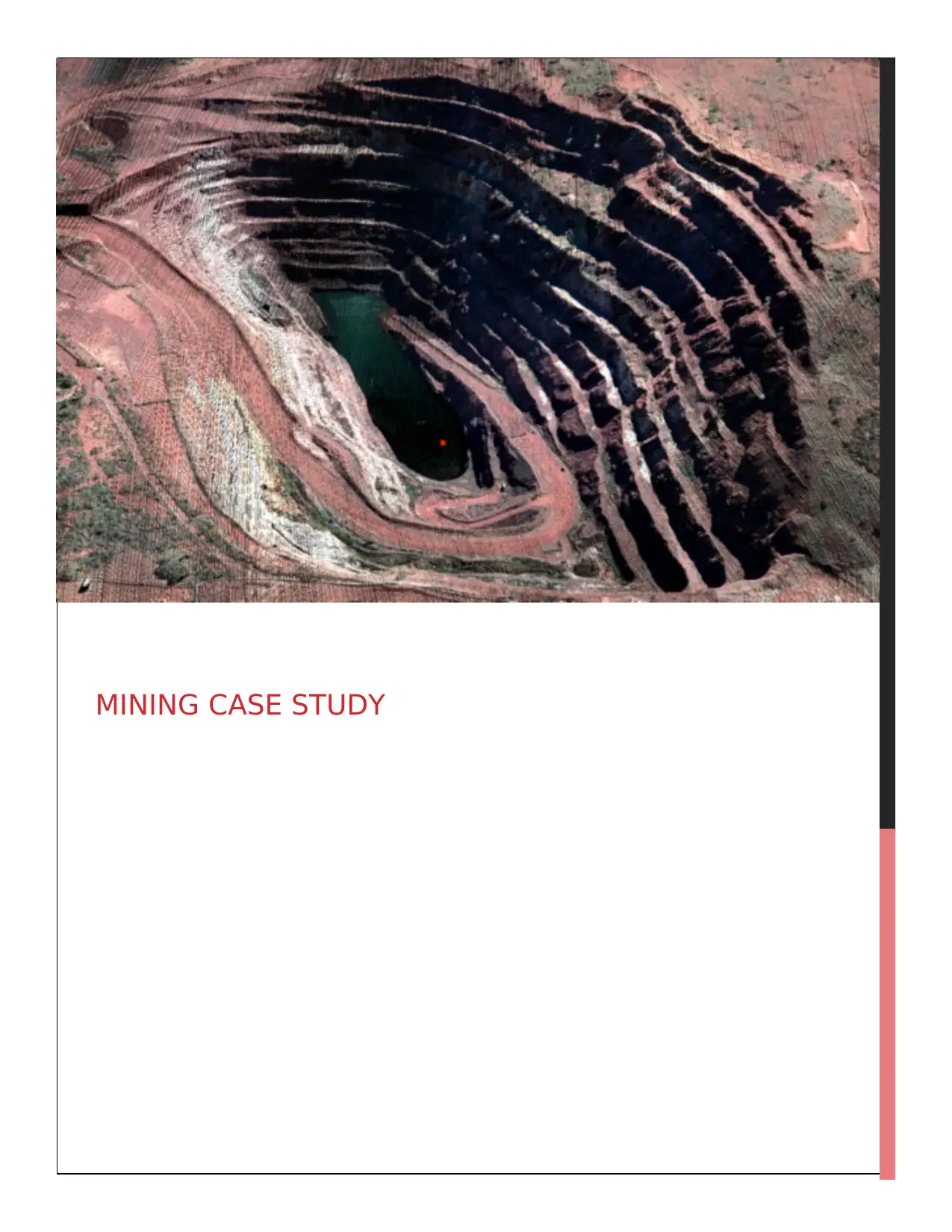
MINING CASE STUDY
Paraphrase This Document
Need a fresh take? Get an instant paraphrase of this document with our AI Paraphraser
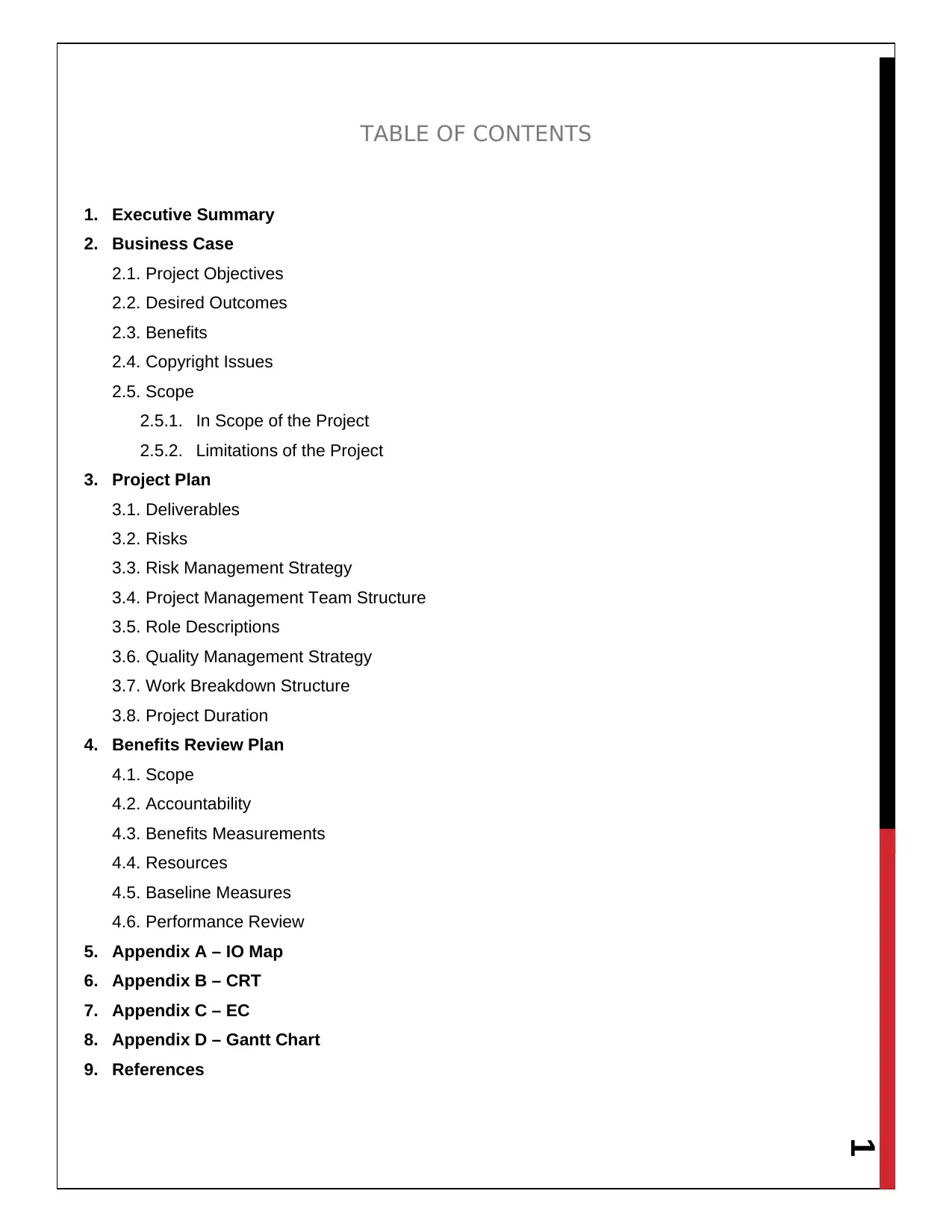
1
TABLE OF CONTENTS
1. Executive Summary
2. Business Case
2.1. Project Objectives
2.2. Desired Outcomes
2.3. Benefits
2.4. Copyright Issues
2.5. Scope
2.5.1. In Scope of the Project
2.5.2. Limitations of the Project
3. Project Plan
3.1. Deliverables
3.2. Risks
3.3. Risk Management Strategy
3.4. Project Management Team Structure
3.5. Role Descriptions
3.6. Quality Management Strategy
3.7. Work Breakdown Structure
3.8. Project Duration
4. Benefits Review Plan
4.1. Scope
4.2. Accountability
4.3. Benefits Measurements
4.4. Resources
4.5. Baseline Measures
4.6. Performance Review
5. Appendix A – IO Map
6. Appendix B – CRT
7. Appendix C – EC
8. Appendix D – Gantt Chart
9. References
TABLE OF CONTENTS
1. Executive Summary
2. Business Case
2.1. Project Objectives
2.2. Desired Outcomes
2.3. Benefits
2.4. Copyright Issues
2.5. Scope
2.5.1. In Scope of the Project
2.5.2. Limitations of the Project
3. Project Plan
3.1. Deliverables
3.2. Risks
3.3. Risk Management Strategy
3.4. Project Management Team Structure
3.5. Role Descriptions
3.6. Quality Management Strategy
3.7. Work Breakdown Structure
3.8. Project Duration
4. Benefits Review Plan
4.1. Scope
4.2. Accountability
4.3. Benefits Measurements
4.4. Resources
4.5. Baseline Measures
4.6. Performance Review
5. Appendix A – IO Map
6. Appendix B – CRT
7. Appendix C – EC
8. Appendix D – Gantt Chart
9. References
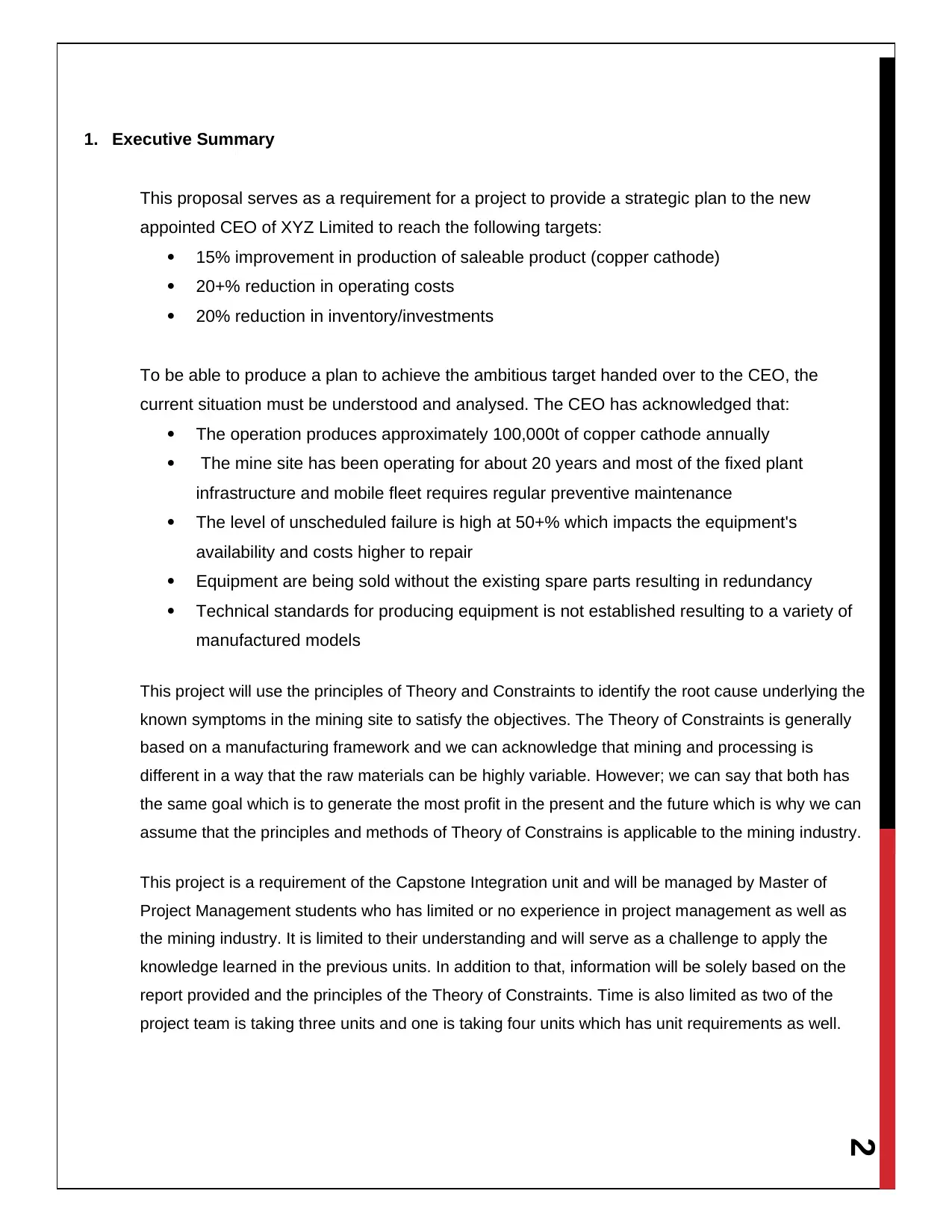
2
1. Executive Summary
This proposal serves as a requirement for a project to provide a strategic plan to the new
appointed CEO of XYZ Limited to reach the following targets:
15% improvement in production of saleable product (copper cathode)
20+% reduction in operating costs
20% reduction in inventory/investments
To be able to produce a plan to achieve the ambitious target handed over to the CEO, the
current situation must be understood and analysed. The CEO has acknowledged that:
The operation produces approximately 100,000t of copper cathode annually
The mine site has been operating for about 20 years and most of the fixed plant
infrastructure and mobile fleet requires regular preventive maintenance
The level of unscheduled failure is high at 50+% which impacts the equipment's
availability and costs higher to repair
Equipment are being sold without the existing spare parts resulting in redundancy
Technical standards for producing equipment is not established resulting to a variety of
manufactured models
This project will use the principles of Theory and Constraints to identify the root cause underlying the
known symptoms in the mining site to satisfy the objectives. The Theory of Constraints is generally
based on a manufacturing framework and we can acknowledge that mining and processing is
different in a way that the raw materials can be highly variable. However; we can say that both has
the same goal which is to generate the most profit in the present and the future which is why we can
assume that the principles and methods of Theory of Constrains is applicable to the mining industry.
This project is a requirement of the Capstone Integration unit and will be managed by Master of
Project Management students who has limited or no experience in project management as well as
the mining industry. It is limited to their understanding and will serve as a challenge to apply the
knowledge learned in the previous units. In addition to that, information will be solely based on the
report provided and the principles of the Theory of Constraints. Time is also limited as two of the
project team is taking three units and one is taking four units which has unit requirements as well.
1. Executive Summary
This proposal serves as a requirement for a project to provide a strategic plan to the new
appointed CEO of XYZ Limited to reach the following targets:
15% improvement in production of saleable product (copper cathode)
20+% reduction in operating costs
20% reduction in inventory/investments
To be able to produce a plan to achieve the ambitious target handed over to the CEO, the
current situation must be understood and analysed. The CEO has acknowledged that:
The operation produces approximately 100,000t of copper cathode annually
The mine site has been operating for about 20 years and most of the fixed plant
infrastructure and mobile fleet requires regular preventive maintenance
The level of unscheduled failure is high at 50+% which impacts the equipment's
availability and costs higher to repair
Equipment are being sold without the existing spare parts resulting in redundancy
Technical standards for producing equipment is not established resulting to a variety of
manufactured models
This project will use the principles of Theory and Constraints to identify the root cause underlying the
known symptoms in the mining site to satisfy the objectives. The Theory of Constraints is generally
based on a manufacturing framework and we can acknowledge that mining and processing is
different in a way that the raw materials can be highly variable. However; we can say that both has
the same goal which is to generate the most profit in the present and the future which is why we can
assume that the principles and methods of Theory of Constrains is applicable to the mining industry.
This project is a requirement of the Capstone Integration unit and will be managed by Master of
Project Management students who has limited or no experience in project management as well as
the mining industry. It is limited to their understanding and will serve as a challenge to apply the
knowledge learned in the previous units. In addition to that, information will be solely based on the
report provided and the principles of the Theory of Constraints. Time is also limited as two of the
project team is taking three units and one is taking four units which has unit requirements as well.
⊘ This is a preview!⊘
Do you want full access?
Subscribe today to unlock all pages.

Trusted by 1+ million students worldwide
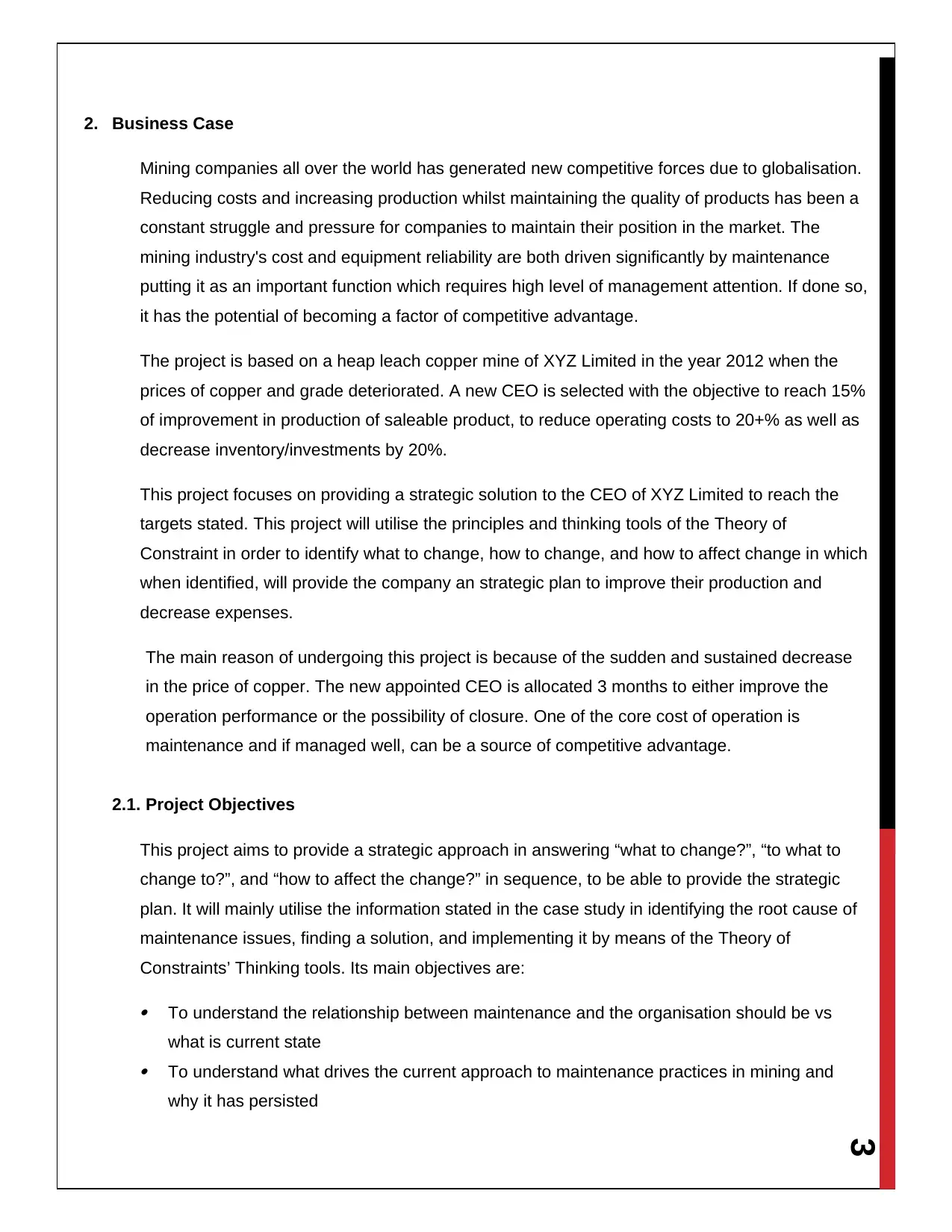
3
2. Business Case
Mining companies all over the world has generated new competitive forces due to globalisation.
Reducing costs and increasing production whilst maintaining the quality of products has been a
constant struggle and pressure for companies to maintain their position in the market. The
mining industry's cost and equipment reliability are both driven significantly by maintenance
putting it as an important function which requires high level of management attention. If done so,
it has the potential of becoming a factor of competitive advantage.
The project is based on a heap leach copper mine of XYZ Limited in the year 2012 when the
prices of copper and grade deteriorated. A new CEO is selected with the objective to reach 15%
of improvement in production of saleable product, to reduce operating costs to 20+% as well as
decrease inventory/investments by 20%.
This project focuses on providing a strategic solution to the CEO of XYZ Limited to reach the
targets stated. This project will utilise the principles and thinking tools of the Theory of
Constraint in order to identify what to change, how to change, and how to affect change in which
when identified, will provide the company an strategic plan to improve their production and
decrease expenses.
The main reason of undergoing this project is because of the sudden and sustained decrease
in the price of copper. The new appointed CEO is allocated 3 months to either improve the
operation performance or the possibility of closure. One of the core cost of operation is
maintenance and if managed well, can be a source of competitive advantage.
2.1. Project Objectives
This project aims to provide a strategic approach in answering “what to change?”, “to what to
change to?”, and “how to affect the change?” in sequence, to be able to provide the strategic
plan. It will mainly utilise the information stated in the case study in identifying the root cause of
maintenance issues, finding a solution, and implementing it by means of the Theory of
Constraints’ Thinking tools. Its main objectives are: To understand the relationship between maintenance and the organisation should be vs
what is current state To understand what drives the current approach to maintenance practices in mining and
why it has persisted
2. Business Case
Mining companies all over the world has generated new competitive forces due to globalisation.
Reducing costs and increasing production whilst maintaining the quality of products has been a
constant struggle and pressure for companies to maintain their position in the market. The
mining industry's cost and equipment reliability are both driven significantly by maintenance
putting it as an important function which requires high level of management attention. If done so,
it has the potential of becoming a factor of competitive advantage.
The project is based on a heap leach copper mine of XYZ Limited in the year 2012 when the
prices of copper and grade deteriorated. A new CEO is selected with the objective to reach 15%
of improvement in production of saleable product, to reduce operating costs to 20+% as well as
decrease inventory/investments by 20%.
This project focuses on providing a strategic solution to the CEO of XYZ Limited to reach the
targets stated. This project will utilise the principles and thinking tools of the Theory of
Constraint in order to identify what to change, how to change, and how to affect change in which
when identified, will provide the company an strategic plan to improve their production and
decrease expenses.
The main reason of undergoing this project is because of the sudden and sustained decrease
in the price of copper. The new appointed CEO is allocated 3 months to either improve the
operation performance or the possibility of closure. One of the core cost of operation is
maintenance and if managed well, can be a source of competitive advantage.
2.1. Project Objectives
This project aims to provide a strategic approach in answering “what to change?”, “to what to
change to?”, and “how to affect the change?” in sequence, to be able to provide the strategic
plan. It will mainly utilise the information stated in the case study in identifying the root cause of
maintenance issues, finding a solution, and implementing it by means of the Theory of
Constraints’ Thinking tools. Its main objectives are: To understand the relationship between maintenance and the organisation should be vs
what is current state To understand what drives the current approach to maintenance practices in mining and
why it has persisted
Paraphrase This Document
Need a fresh take? Get an instant paraphrase of this document with our AI Paraphraser
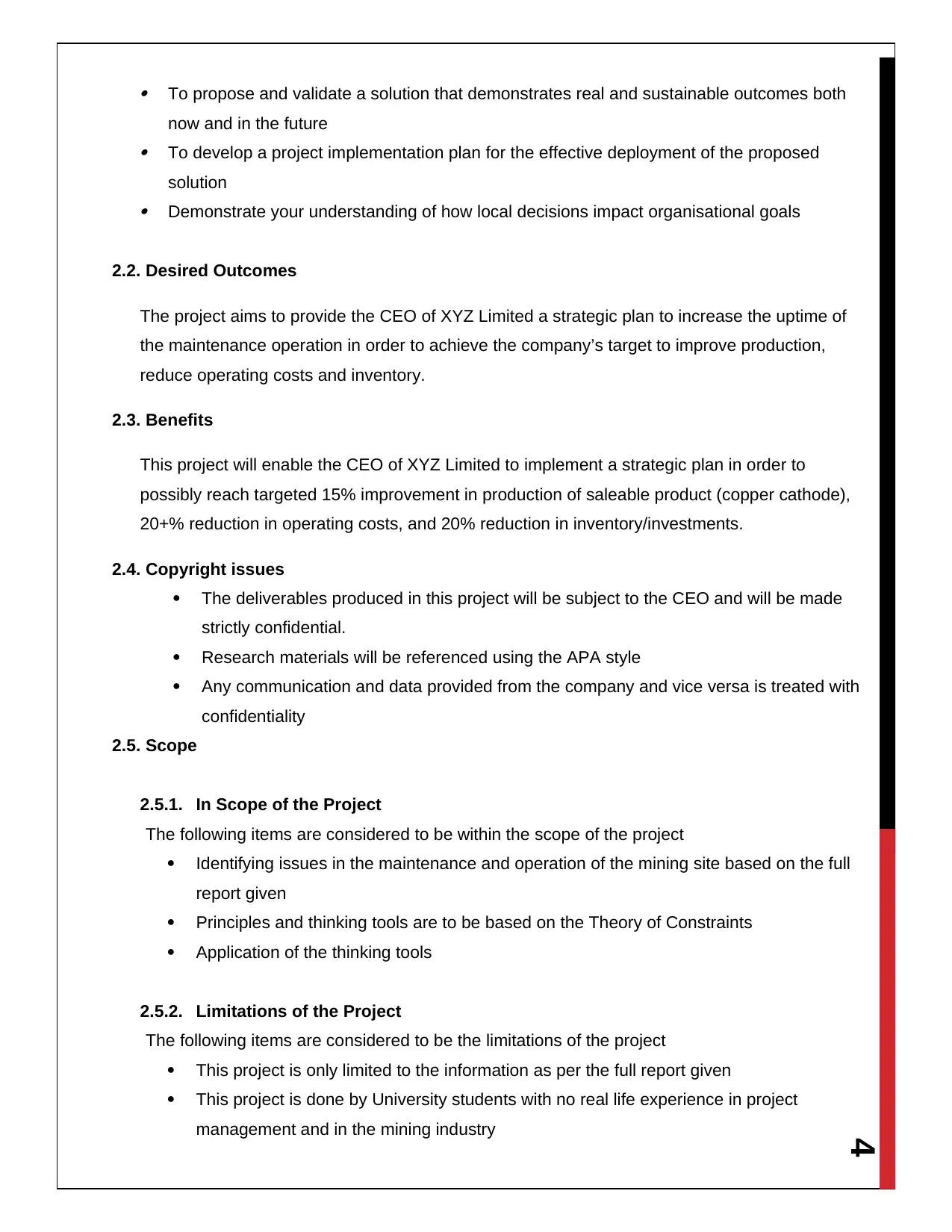
4
To propose and validate a solution that demonstrates real and sustainable outcomes both
now and in the future To develop a project implementation plan for the effective deployment of the proposed
solution Demonstrate your understanding of how local decisions impact organisational goals
2.2. Desired Outcomes
The project aims to provide the CEO of XYZ Limited a strategic plan to increase the uptime of
the maintenance operation in order to achieve the company’s target to improve production,
reduce operating costs and inventory.
2.3. Benefits
This project will enable the CEO of XYZ Limited to implement a strategic plan in order to
possibly reach targeted 15% improvement in production of saleable product (copper cathode),
20+% reduction in operating costs, and 20% reduction in inventory/investments.
2.4. Copyright issues
The deliverables produced in this project will be subject to the CEO and will be made
strictly confidential.
Research materials will be referenced using the APA style
Any communication and data provided from the company and vice versa is treated with
confidentiality
2.5. Scope
2.5.1. In Scope of the Project
The following items are considered to be within the scope of the project
Identifying issues in the maintenance and operation of the mining site based on the full
report given
Principles and thinking tools are to be based on the Theory of Constraints
Application of the thinking tools
2.5.2. Limitations of the Project
The following items are considered to be the limitations of the project
This project is only limited to the information as per the full report given
This project is done by University students with no real life experience in project
management and in the mining industry
To propose and validate a solution that demonstrates real and sustainable outcomes both
now and in the future To develop a project implementation plan for the effective deployment of the proposed
solution Demonstrate your understanding of how local decisions impact organisational goals
2.2. Desired Outcomes
The project aims to provide the CEO of XYZ Limited a strategic plan to increase the uptime of
the maintenance operation in order to achieve the company’s target to improve production,
reduce operating costs and inventory.
2.3. Benefits
This project will enable the CEO of XYZ Limited to implement a strategic plan in order to
possibly reach targeted 15% improvement in production of saleable product (copper cathode),
20+% reduction in operating costs, and 20% reduction in inventory/investments.
2.4. Copyright issues
The deliverables produced in this project will be subject to the CEO and will be made
strictly confidential.
Research materials will be referenced using the APA style
Any communication and data provided from the company and vice versa is treated with
confidentiality
2.5. Scope
2.5.1. In Scope of the Project
The following items are considered to be within the scope of the project
Identifying issues in the maintenance and operation of the mining site based on the full
report given
Principles and thinking tools are to be based on the Theory of Constraints
Application of the thinking tools
2.5.2. Limitations of the Project
The following items are considered to be the limitations of the project
This project is only limited to the information as per the full report given
This project is done by University students with no real life experience in project
management and in the mining industry
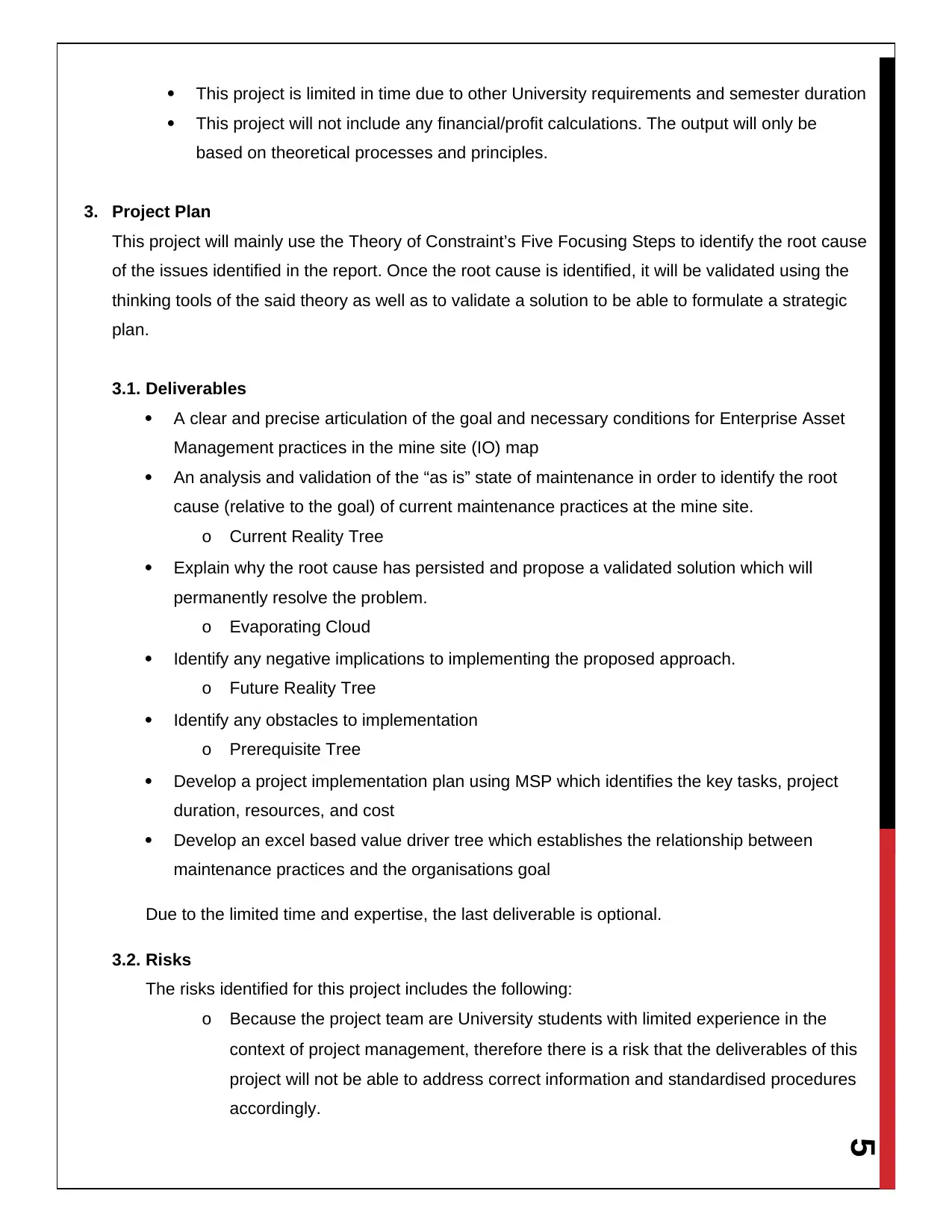
5
This project is limited in time due to other University requirements and semester duration
This project will not include any financial/profit calculations. The output will only be
based on theoretical processes and principles.
3. Project Plan
This project will mainly use the Theory of Constraint’s Five Focusing Steps to identify the root cause
of the issues identified in the report. Once the root cause is identified, it will be validated using the
thinking tools of the said theory as well as to validate a solution to be able to formulate a strategic
plan.
3.1. Deliverables
A clear and precise articulation of the goal and necessary conditions for Enterprise Asset
Management practices in the mine site (IO) map
An analysis and validation of the “as is” state of maintenance in order to identify the root
cause (relative to the goal) of current maintenance practices at the mine site.
o Current Reality Tree
Explain why the root cause has persisted and propose a validated solution which will
permanently resolve the problem.
o Evaporating Cloud
Identify any negative implications to implementing the proposed approach.
o Future Reality Tree
Identify any obstacles to implementation
o Prerequisite Tree
Develop a project implementation plan using MSP which identifies the key tasks, project
duration, resources, and cost
Develop an excel based value driver tree which establishes the relationship between
maintenance practices and the organisations goal
Due to the limited time and expertise, the last deliverable is optional.
3.2. Risks
The risks identified for this project includes the following:
o Because the project team are University students with limited experience in the
context of project management, therefore there is a risk that the deliverables of this
project will not be able to address correct information and standardised procedures
accordingly.
This project is limited in time due to other University requirements and semester duration
This project will not include any financial/profit calculations. The output will only be
based on theoretical processes and principles.
3. Project Plan
This project will mainly use the Theory of Constraint’s Five Focusing Steps to identify the root cause
of the issues identified in the report. Once the root cause is identified, it will be validated using the
thinking tools of the said theory as well as to validate a solution to be able to formulate a strategic
plan.
3.1. Deliverables
A clear and precise articulation of the goal and necessary conditions for Enterprise Asset
Management practices in the mine site (IO) map
An analysis and validation of the “as is” state of maintenance in order to identify the root
cause (relative to the goal) of current maintenance practices at the mine site.
o Current Reality Tree
Explain why the root cause has persisted and propose a validated solution which will
permanently resolve the problem.
o Evaporating Cloud
Identify any negative implications to implementing the proposed approach.
o Future Reality Tree
Identify any obstacles to implementation
o Prerequisite Tree
Develop a project implementation plan using MSP which identifies the key tasks, project
duration, resources, and cost
Develop an excel based value driver tree which establishes the relationship between
maintenance practices and the organisations goal
Due to the limited time and expertise, the last deliverable is optional.
3.2. Risks
The risks identified for this project includes the following:
o Because the project team are University students with limited experience in the
context of project management, therefore there is a risk that the deliverables of this
project will not be able to address correct information and standardised procedures
accordingly.
⊘ This is a preview!⊘
Do you want full access?
Subscribe today to unlock all pages.

Trusted by 1+ million students worldwide

6
o Because the project team has limited knowledge of the mining industry and is
limited to the report and basic research, therefore there is a risk of misinterpretation
on the information processed that may affect the outcome of the case study
o Aside from the demands of this project, the project team has other obligations to
their other units therefore there is a risk not managing the schedule and time well to
complete all deliverables
3.3. Risk Management Strategy
The main purpose of the risk management strategy is to identify the risk events in the early
stages of the projects. It helps to minimise the risks, and avoid from project failure and assist the
project to deliver desired outcome on time in efficient and effective manner. The project
manager needs to identify the risk category whether it is internal, external or project
environment related. The risk management procedure is based on PRINCE 2. Initial risk
identification will take place during the project kick-off meeting and will be a subsequent project
meeting. After identifying, the risk level can be calculated using the risk matrix.
3.4. Project Management Team Structure
The project has the following structure. The Project Client and is Gordon Dunbar and the Project
Advisor is Gordon Dunbar and Dr Phil Dobson and rest as the project team.
Client: Gordon
Dunbar
Project Manager:
Marie Castillones
Project Support
Team: Nemesh
Ashvinbhai
Project Management
Team: Anusha
Dilshyani
Proj. Advisor:
Gordon
Dunbar
Proj. Advisor:
Dr. Phil
Dobson
o Because the project team has limited knowledge of the mining industry and is
limited to the report and basic research, therefore there is a risk of misinterpretation
on the information processed that may affect the outcome of the case study
o Aside from the demands of this project, the project team has other obligations to
their other units therefore there is a risk not managing the schedule and time well to
complete all deliverables
3.3. Risk Management Strategy
The main purpose of the risk management strategy is to identify the risk events in the early
stages of the projects. It helps to minimise the risks, and avoid from project failure and assist the
project to deliver desired outcome on time in efficient and effective manner. The project
manager needs to identify the risk category whether it is internal, external or project
environment related. The risk management procedure is based on PRINCE 2. Initial risk
identification will take place during the project kick-off meeting and will be a subsequent project
meeting. After identifying, the risk level can be calculated using the risk matrix.
3.4. Project Management Team Structure
The project has the following structure. The Project Client and is Gordon Dunbar and the Project
Advisor is Gordon Dunbar and Dr Phil Dobson and rest as the project team.
Client: Gordon
Dunbar
Project Manager:
Marie Castillones
Project Support
Team: Nemesh
Ashvinbhai
Project Management
Team: Anusha
Dilshyani
Proj. Advisor:
Gordon
Dunbar
Proj. Advisor:
Dr. Phil
Dobson
Paraphrase This Document
Need a fresh take? Get an instant paraphrase of this document with our AI Paraphraser
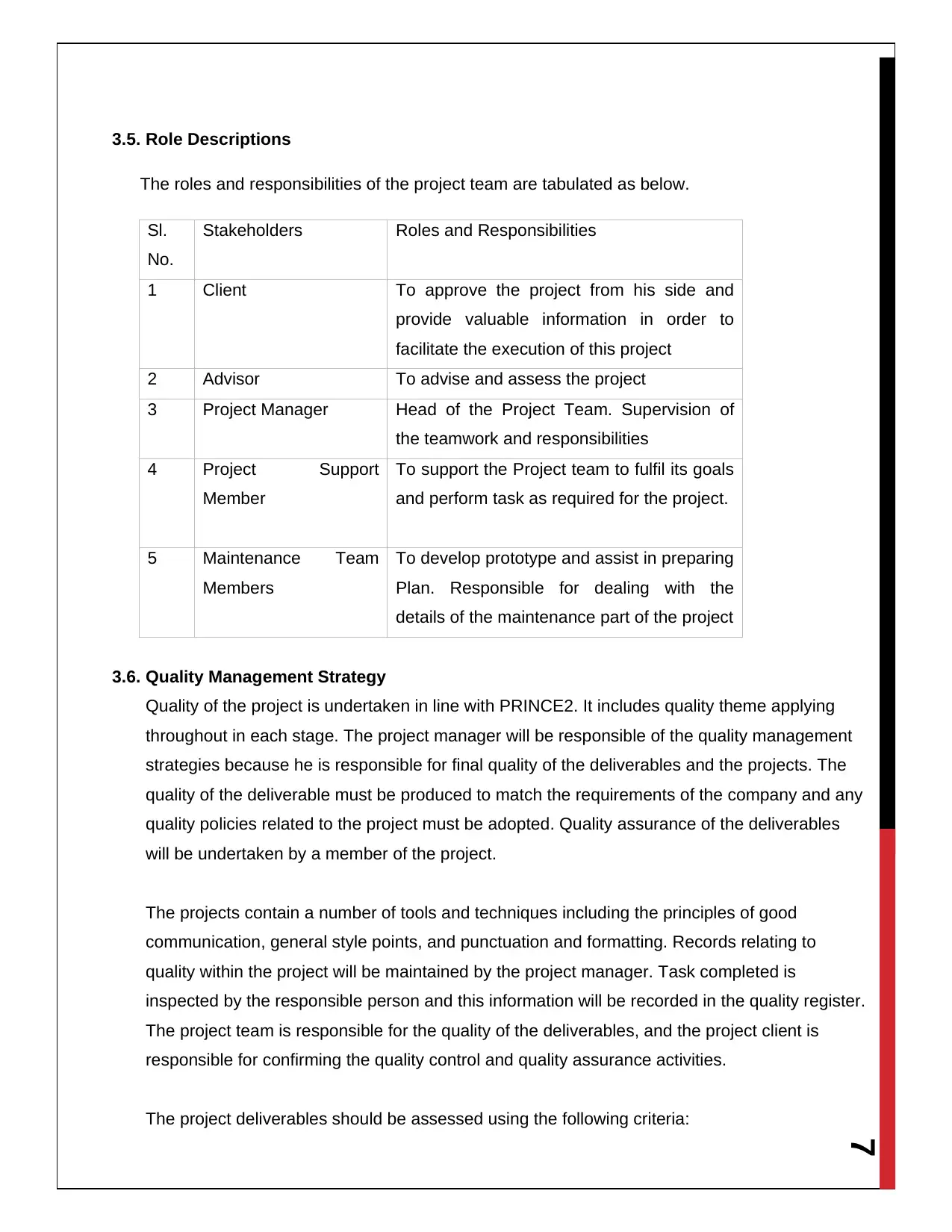
7
3.5. Role Descriptions
The roles and responsibilities of the project team are tabulated as below.
Sl.
No.
Stakeholders Roles and Responsibilities
1 Client To approve the project from his side and
provide valuable information in order to
facilitate the execution of this project
2 Advisor To advise and assess the project
3 Project Manager Head of the Project Team. Supervision of
the teamwork and responsibilities
4 Project Support
Member
To support the Project team to fulfil its goals
and perform task as required for the project.
5 Maintenance Team
Members
To develop prototype and assist in preparing
Plan. Responsible for dealing with the
details of the maintenance part of the project
3.6. Quality Management Strategy
Quality of the project is undertaken in line with PRINCE2. It includes quality theme applying
throughout in each stage. The project manager will be responsible of the quality management
strategies because he is responsible for final quality of the deliverables and the projects. The
quality of the deliverable must be produced to match the requirements of the company and any
quality policies related to the project must be adopted. Quality assurance of the deliverables
will be undertaken by a member of the project.
The projects contain a number of tools and techniques including the principles of good
communication, general style points, and punctuation and formatting. Records relating to
quality within the project will be maintained by the project manager. Task completed is
inspected by the responsible person and this information will be recorded in the quality register.
The project team is responsible for the quality of the deliverables, and the project client is
responsible for confirming the quality control and quality assurance activities.
The project deliverables should be assessed using the following criteria:
3.5. Role Descriptions
The roles and responsibilities of the project team are tabulated as below.
Sl.
No.
Stakeholders Roles and Responsibilities
1 Client To approve the project from his side and
provide valuable information in order to
facilitate the execution of this project
2 Advisor To advise and assess the project
3 Project Manager Head of the Project Team. Supervision of
the teamwork and responsibilities
4 Project Support
Member
To support the Project team to fulfil its goals
and perform task as required for the project.
5 Maintenance Team
Members
To develop prototype and assist in preparing
Plan. Responsible for dealing with the
details of the maintenance part of the project
3.6. Quality Management Strategy
Quality of the project is undertaken in line with PRINCE2. It includes quality theme applying
throughout in each stage. The project manager will be responsible of the quality management
strategies because he is responsible for final quality of the deliverables and the projects. The
quality of the deliverable must be produced to match the requirements of the company and any
quality policies related to the project must be adopted. Quality assurance of the deliverables
will be undertaken by a member of the project.
The projects contain a number of tools and techniques including the principles of good
communication, general style points, and punctuation and formatting. Records relating to
quality within the project will be maintained by the project manager. Task completed is
inspected by the responsible person and this information will be recorded in the quality register.
The project team is responsible for the quality of the deliverables, and the project client is
responsible for confirming the quality control and quality assurance activities.
The project deliverables should be assessed using the following criteria:

8
Confirmation that the project has been undertaken in line with PRINCE2 project
management principles
Completion of the project against the agreed proposal
Satisfactory and appropriate communication with the unit coordinator and the
stakeholders
Feedback from the stakeholders regarding the quality of the products
Feedback from the stakeholders regarding the performance.
Quality Control
Confirmation that the project has been undertaken in line with PRINCE2 project
management principles
Completion of the project against the agreed proposal
Satisfactory and appropriate communication with the unit coordinator and the
stakeholders
Feedback from the stakeholders regarding the quality of the products
Feedback from the stakeholders regarding the performance.
Quality Control
⊘ This is a preview!⊘
Do you want full access?
Subscribe today to unlock all pages.

Trusted by 1+ million students worldwide
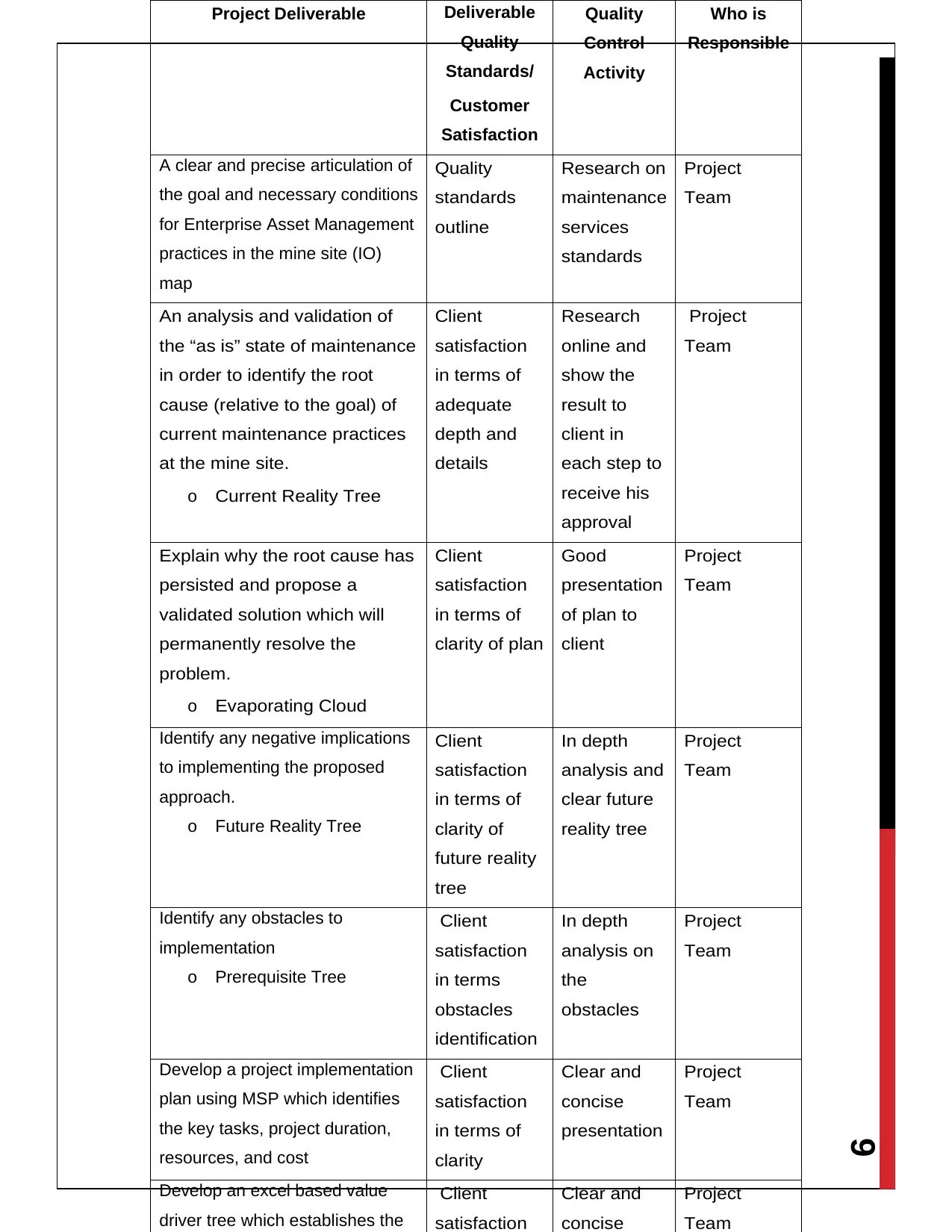
9
Project Deliverable Deliverable
Quality
Standards/
Customer
Satisfaction
Quality
Control
Activity
Who is
Responsible
A clear and precise articulation of
the goal and necessary conditions
for Enterprise Asset Management
practices in the mine site (IO)
map
Quality
standards
outline
Research on
maintenance
services
standards
Project
Team
An analysis and validation of
the “as is” state of maintenance
in order to identify the root
cause (relative to the goal) of
current maintenance practices
at the mine site.
o Current Reality Tree
Client
satisfaction
in terms of
adequate
depth and
details
Research
online and
show the
result to
client in
each step to
receive his
approval
Project
Team
Explain why the root cause has
persisted and propose a
validated solution which will
permanently resolve the
problem.
o Evaporating Cloud
Client
satisfaction
in terms of
clarity of plan
Good
presentation
of plan to
client
Project
Team
Identify any negative implications
to implementing the proposed
approach.
o Future Reality Tree
Client
satisfaction
in terms of
clarity of
future reality
tree
In depth
analysis and
clear future
reality tree
Project
Team
Identify any obstacles to
implementation
o Prerequisite Tree
Client
satisfaction
in terms
obstacles
identification
In depth
analysis on
the
obstacles
Project
Team
Develop a project implementation
plan using MSP which identifies
the key tasks, project duration,
resources, and cost
Client
satisfaction
in terms of
clarity
Clear and
concise
presentation
Project
Team
Develop an excel based value
driver tree which establishes the
Client
satisfaction
Clear and
concise
Project
Team
Project Deliverable Deliverable
Quality
Standards/
Customer
Satisfaction
Quality
Control
Activity
Who is
Responsible
A clear and precise articulation of
the goal and necessary conditions
for Enterprise Asset Management
practices in the mine site (IO)
map
Quality
standards
outline
Research on
maintenance
services
standards
Project
Team
An analysis and validation of
the “as is” state of maintenance
in order to identify the root
cause (relative to the goal) of
current maintenance practices
at the mine site.
o Current Reality Tree
Client
satisfaction
in terms of
adequate
depth and
details
Research
online and
show the
result to
client in
each step to
receive his
approval
Project
Team
Explain why the root cause has
persisted and propose a
validated solution which will
permanently resolve the
problem.
o Evaporating Cloud
Client
satisfaction
in terms of
clarity of plan
Good
presentation
of plan to
client
Project
Team
Identify any negative implications
to implementing the proposed
approach.
o Future Reality Tree
Client
satisfaction
in terms of
clarity of
future reality
tree
In depth
analysis and
clear future
reality tree
Project
Team
Identify any obstacles to
implementation
o Prerequisite Tree
Client
satisfaction
in terms
obstacles
identification
In depth
analysis on
the
obstacles
Project
Team
Develop a project implementation
plan using MSP which identifies
the key tasks, project duration,
resources, and cost
Client
satisfaction
in terms of
clarity
Clear and
concise
presentation
Project
Team
Develop an excel based value
driver tree which establishes the
Client
satisfaction
Clear and
concise
Project
Team
Paraphrase This Document
Need a fresh take? Get an instant paraphrase of this document with our AI Paraphraser
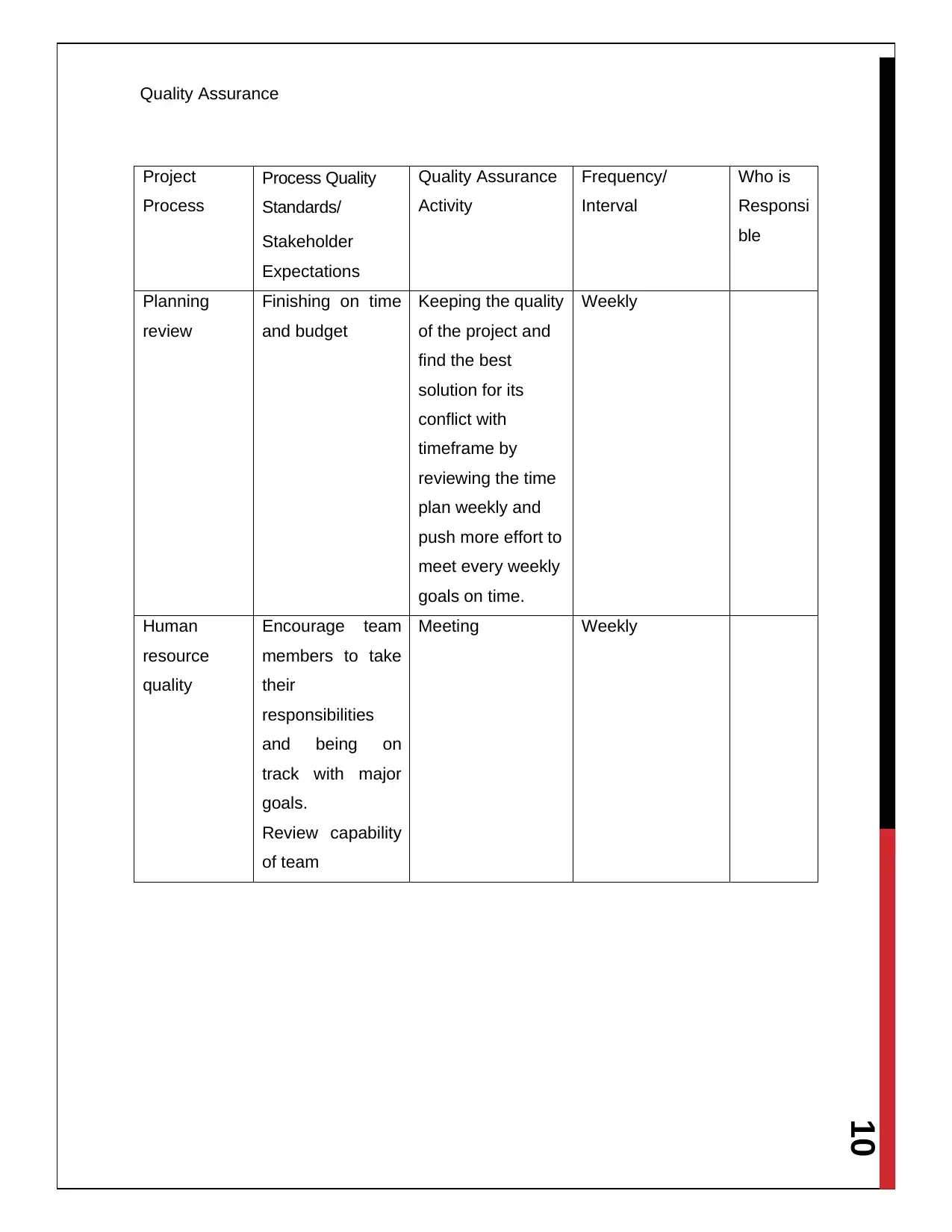
10
Quality Assurance
Project
Process
Process Quality
Standards/
Stakeholder
Expectations
Quality Assurance
Activity
Frequency/
Interval
Who is
Responsi
ble
Planning
review
Finishing on time
and budget
Keeping the quality
of the project and
find the best
solution for its
conflict with
timeframe by
reviewing the time
plan weekly and
push more effort to
meet every weekly
goals on time.
Weekly
Human
resource
quality
Encourage team
members to take
their
responsibilities
and being on
track with major
goals.
Review capability
of team
Meeting Weekly
Quality Assurance
Project
Process
Process Quality
Standards/
Stakeholder
Expectations
Quality Assurance
Activity
Frequency/
Interval
Who is
Responsi
ble
Planning
review
Finishing on time
and budget
Keeping the quality
of the project and
find the best
solution for its
conflict with
timeframe by
reviewing the time
plan weekly and
push more effort to
meet every weekly
goals on time.
Weekly
Human
resource
quality
Encourage team
members to take
their
responsibilities
and being on
track with major
goals.
Review capability
of team
Meeting Weekly
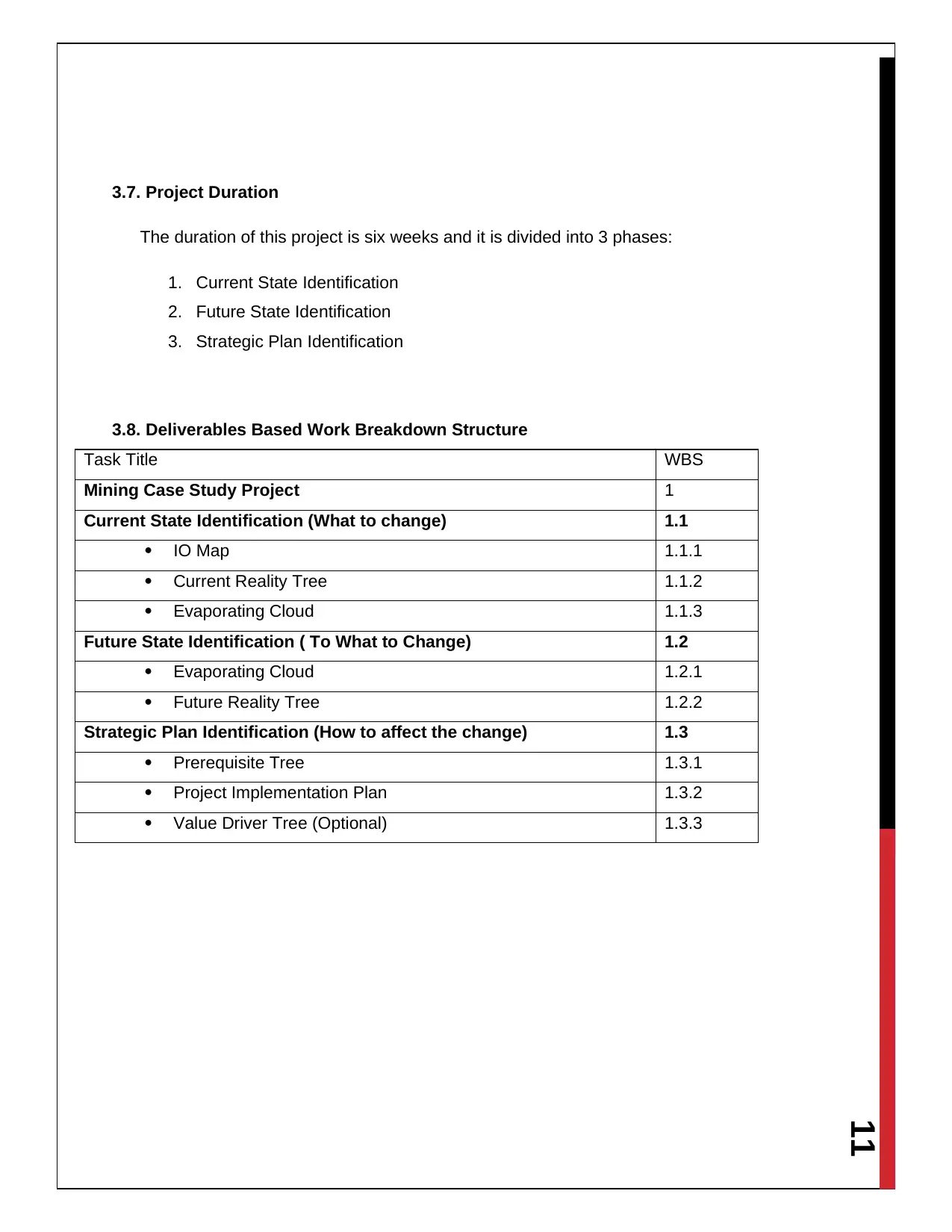
11
3.7. Project Duration
The duration of this project is six weeks and it is divided into 3 phases:
1. Current State Identification
2. Future State Identification
3. Strategic Plan Identification
3.8. Deliverables Based Work Breakdown Structure
Task Title WBS
Mining Case Study Project 1
Current State Identification (What to change) 1.1
IO Map 1.1.1
Current Reality Tree 1.1.2
Evaporating Cloud 1.1.3
Future State Identification ( To What to Change) 1.2
Evaporating Cloud 1.2.1
Future Reality Tree 1.2.2
Strategic Plan Identification (How to affect the change) 1.3
Prerequisite Tree 1.3.1
Project Implementation Plan 1.3.2
Value Driver Tree (Optional) 1.3.3
3.7. Project Duration
The duration of this project is six weeks and it is divided into 3 phases:
1. Current State Identification
2. Future State Identification
3. Strategic Plan Identification
3.8. Deliverables Based Work Breakdown Structure
Task Title WBS
Mining Case Study Project 1
Current State Identification (What to change) 1.1
IO Map 1.1.1
Current Reality Tree 1.1.2
Evaporating Cloud 1.1.3
Future State Identification ( To What to Change) 1.2
Evaporating Cloud 1.2.1
Future Reality Tree 1.2.2
Strategic Plan Identification (How to affect the change) 1.3
Prerequisite Tree 1.3.1
Project Implementation Plan 1.3.2
Value Driver Tree (Optional) 1.3.3
⊘ This is a preview!⊘
Do you want full access?
Subscribe today to unlock all pages.

Trusted by 1+ million students worldwide
1 out of 18
Related Documents
Your All-in-One AI-Powered Toolkit for Academic Success.
+13062052269
info@desklib.com
Available 24*7 on WhatsApp / Email
![[object Object]](/_next/static/media/star-bottom.7253800d.svg)
Unlock your academic potential
Copyright © 2020–2025 A2Z Services. All Rights Reserved. Developed and managed by ZUCOL.



